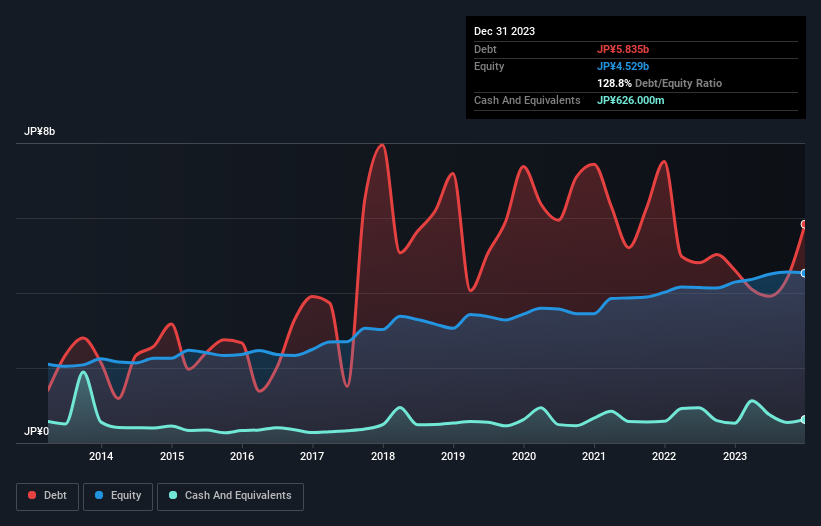Ishikawa Seisakusho (TSE:6208) Takes On Some Risk With Its Use Of Debt

Legendary fund manager Li Lu (who Charlie Munger backed) once said, 'The biggest investment risk is not the volatility of prices, but whether you will suffer a permanent loss of capital.' It's only natural to consider a company's balance sheet when you examine how risky it is, since debt is often involved when a business collapses. Importantly, Ishikawa Seisakusho, Ltd. (TSE:6208) does carry debt. But the more important question is: how much risk is that debt creating?
What Risk Does Debt Bring?
Debt is a tool to help businesses grow, but if a business is incapable of paying off its lenders, then it exists at their mercy. If things get really bad, the lenders can take control of the business. While that is not too common, we often do see indebted companies permanently diluting shareholders because lenders force them to raise capital at a distressed price. Of course, the upside of debt is that it often represents cheap capital, especially when it replaces dilution in a company with the ability to reinvest at high rates of return. When we examine debt levels, we first consider both cash and debt levels, together.
See our latest analysis for Ishikawa Seisakusho
What Is Ishikawa Seisakusho's Net Debt?
The image below, which you can click on for greater detail, shows that at December 2023 Ishikawa Seisakusho had debt of JP¥5.84b, up from JP¥4.62b in one year. However, it also had JP¥626.0m in cash, and so its net debt is JP¥5.21b.

How Healthy Is Ishikawa Seisakusho's Balance Sheet?
According to the last reported balance sheet, Ishikawa Seisakusho had liabilities of JP¥10.1b due within 12 months, and liabilities of JP¥1.72b due beyond 12 months. Offsetting these obligations, it had cash of JP¥626.0m as well as receivables valued at JP¥5.52b due within 12 months. So its liabilities total JP¥5.68b more than the combination of its cash and short-term receivables.
This deficit is considerable relative to its market capitalization of JP¥8.56b, so it does suggest shareholders should keep an eye on Ishikawa Seisakusho's use of debt. This suggests shareholders would be heavily diluted if the company needed to shore up its balance sheet in a hurry.
We use two main ratios to inform us about debt levels relative to earnings. The first is net debt divided by earnings before interest, tax, depreciation, and amortization (EBITDA), while the second is how many times its earnings before interest and tax (EBIT) covers its interest expense (or its interest cover, for short). The advantage of this approach is that we take into account both the absolute quantum of debt (with net debt to EBITDA) and the actual interest expenses associated with that debt (with its interest cover ratio).
Strangely Ishikawa Seisakusho has a sky high EBITDA ratio of 18.0, implying high debt, but a strong interest coverage of 19.3. So either it has access to very cheap long term debt or that interest expense is going to grow! Importantly, Ishikawa Seisakusho's EBIT fell a jaw-dropping 68% in the last twelve months. If that decline continues then paying off debt will be harder than selling foie gras at a vegan convention. When analysing debt levels, the balance sheet is the obvious place to start. But you can't view debt in total isolation; since Ishikawa Seisakusho will need earnings to service that debt. So when considering debt, it's definitely worth looking at the earnings trend. Click here for an interactive snapshot.
Finally, a business needs free cash flow to pay off debt; accounting profits just don't cut it. So the logical step is to look at the proportion of that EBIT that is matched by actual free cash flow. Over the last three years, Ishikawa Seisakusho actually produced more free cash flow than EBIT. That sort of strong cash generation warms our hearts like a puppy in a bumblebee suit.
Our View
We feel some trepidation about Ishikawa Seisakusho's difficulty EBIT growth rate, but we've got positives to focus on, too. To wit both its interest cover and conversion of EBIT to free cash flow were encouraging signs. Taking the abovementioned factors together we do think Ishikawa Seisakusho's debt poses some risks to the business. While that debt can boost returns, we think the company has enough leverage now. There's no doubt that we learn most about debt from the balance sheet. But ultimately, every company can contain risks that exist outside of the balance sheet. For example Ishikawa Seisakusho has 3 warning signs (and 1 which is concerning) we think you should know about.
Of course, if you're the type of investor who prefers buying stocks without the burden of debt, then don't hesitate to discover our exclusive list of net cash growth stocks, today.
New: AI Stock Screener & Alerts
Our new AI Stock Screener scans the market every day to uncover opportunities.
• Dividend Powerhouses (3%+ Yield)
• Undervalued Small Caps with Insider Buying
• High growth Tech and AI Companies
Or build your own from over 50 metrics.
Have feedback on this article? Concerned about the content? Get in touch with us directly. Alternatively, email editorial-team (at) simplywallst.com.
This article by Simply Wall St is general in nature. We provide commentary based on historical data and analyst forecasts only using an unbiased methodology and our articles are not intended to be financial advice. It does not constitute a recommendation to buy or sell any stock, and does not take account of your objectives, or your financial situation. We aim to bring you long-term focused analysis driven by fundamental data. Note that our analysis may not factor in the latest price-sensitive company announcements or qualitative material. Simply Wall St has no position in any stocks mentioned.
About TSE:6208
Solid track record with adequate balance sheet.


